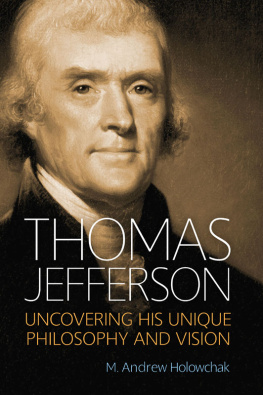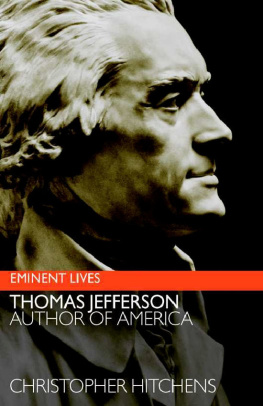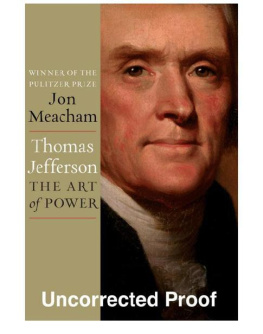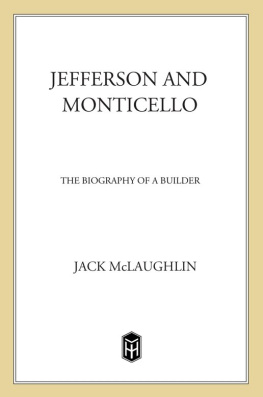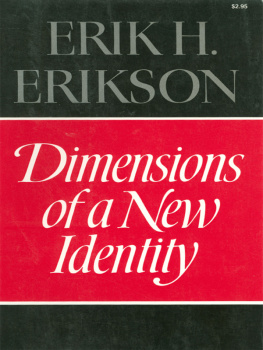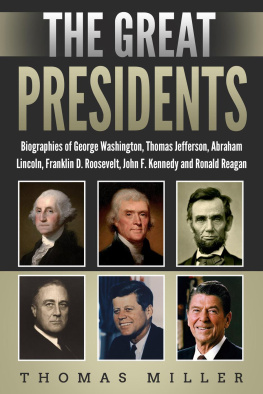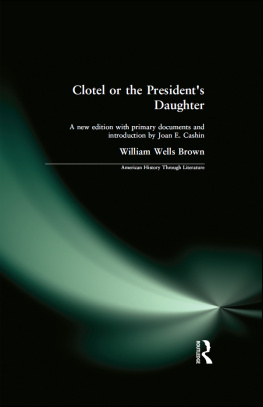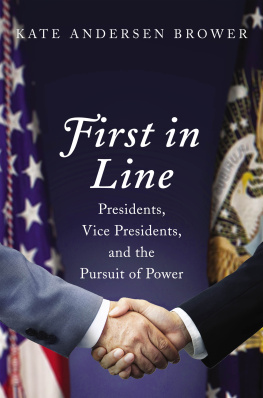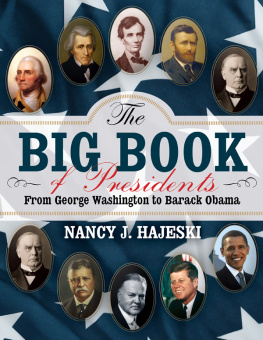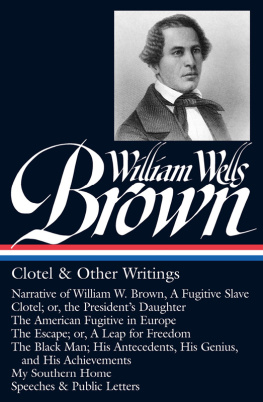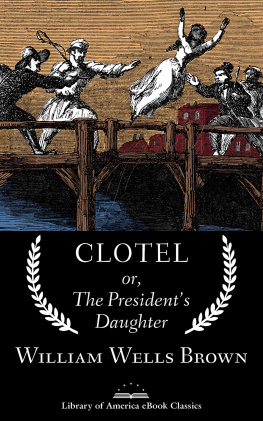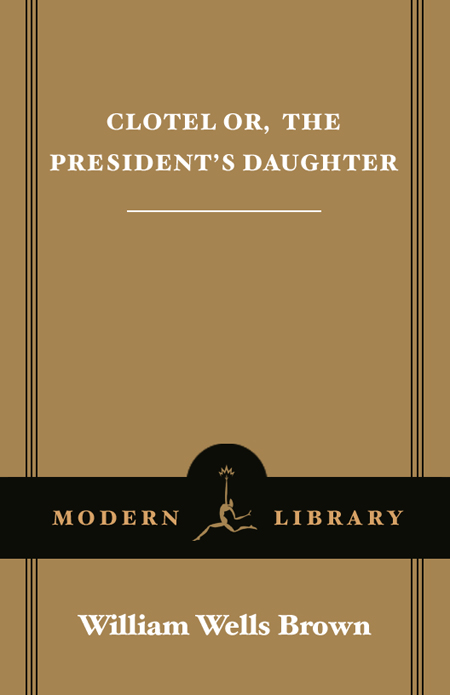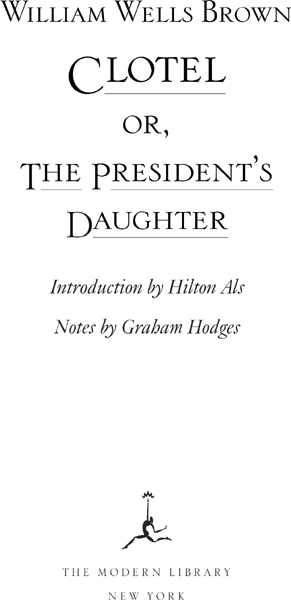W ILLIAM W ELLS B ROWN
William Wells Brown, the abolitionist and social reformer who is best remembered as this countrys first black novelist and playwright as well as one of the earliest African-American historians, was born circa 1814 on a plantation near Lexington, Kentucky. The son of a slave woman named Elizabeth and a white man, most likely a relative of her owner, he grew up on a farm in the Missouri Territory but was often hired out by his master to various employers. At the age of sixteen he worked in the St. Louis printing office of abolitionist Elijah Lovejoy a kindly newspaper editor who equipped him with a rudimentary education. A subsequent period of forced employment for a slave trader in New Orleans induced him to flee the South.
Brown escaped from slavery on New Years Day, 1834, while working aboard a steamboat docked in Cincinnati. With the help of Wells Brown, an Ohio Quaker whose name he assumed, Brown eventually reached freedom in Cleveland. By the time he settled in Buffalo in 1836, Brown had become a committed abolitionist. Employed for several years as a steward on Lake Erie steamers, he regularly helped fugitive slaves escape to Canada, and in the fall of 1843 he was hired as a full-time lecturer by the Western New York Anti-Slavery Society. Brown moved to Boston in 1847 and published a best-selling memoir, Narrative of William W. Brown, a Fugitive Slave, Written by Himself. The following year he brought out The Anti-Slavery Harp, a collection of antislavery songs.
Owing to the popularity of these two works, as well as his skills as a speaker, Brown was chosen by the American Peace Society to be its representative to the Paris Peace Congress of 1849. Three Years in Europe (1852), a compilation of letters to friends such as Frederick Douglass, relates his experiences in France and England. While still living abroad he wrote Clotel; or, The Presidents Daughter: A Narrative of Slave Life in the United States (1853), the first novel by an African-American. The story of Thomas Jeffersons secret mulatto daughter and her sale into slavery, Clotel was later revised and republished in the United States under three different titles. It was serialized in the Weekly Anglo-African from December 1860 through March 1861 as Miralda; or, The Beautiful Quadroon. In 1864 it reappeared as Clotelle: A Tale of the Southern States and in 1867 as Clotelle;0 or, the Colored Heroine
Brown negotiated to buy his freedom in 1854 for the sum of three hundred dollars. No longer fearing the possibility of capture and reenslavement, he returned to Boston and began lecturing for the American Anti-Slavery Society. In 1856 he wrote Experience; or, How to Give a Northern Man a Backbone, a drama that satirized the proslavery tracts of clergyman Nehemiah Adams and was applauded by abolitionist audiences. Encouraged by its success, Brown turned out The Escape; or, a Leap for Freedom (1858), a semi-autobiographical melodrama generally regarded as the first play ever published by an African-American writer.
With the outbreak of the Civil War, in 1861, Brown shifted his focus to recording the history of blacks in America. His first major historical work, The Black Man: His Antecedents, His Genius, and His Achievements (1863), refutes negative racial stereotypes by offering biographical sketches of noteworthy African-Americans. Afterward he wrote The Negro in the American Rebellion, His Heroism and His Fidelity (1867), a pioneering study of the role of blacks in the American Revolution, the War of 1812, and the Civil War. The Rising Son;or, Antecedents and Advancement of the Colored Race (1874), perhaps Browns most important and popular history, chronicles slave life throughout the Americas and the Caribbean while also preserving the individual stories of scores of African-Americans.
Brown devoted the last twenty years of his life to temperance reform and crusading for black suffrage as well as the practice of medicine, a field in which he was largely self-taught. Browns final book, My Southern Home; or, The South and Its People (1880), a reminiscence of slave life coupled with an account of his trip through the new South during the winter of 1879-80, reports on the growing despair and oppression of southern blacks. Some critics view it as a forerunner of W.E.B. Du Boiss monumental work, The Souls of Black Folk (1903). William Wells Brown died at the age of seventy in Chelsea, Massachusetts, on November 6, 1884.
C ONTENTS
I NTRODUCTION
Hilton Als
You know how some girls arethey want you to look and they dont want you to look. In the 1992 television miniseries Queen, based on the late Alex Haleys unfinished biographical story Halle Berry the young biracial actress best known for her efforts, on TV, to come to terms with her abusive, often absent black father and his relationship to her white mother, as well as her portrayal, again on television, of the colored film star Dorothy Dandridge, plays Queen while wearing a pronounced cosmetic mask over her barely emotive face. Berrys turn as Queenwho, in addition to being Haleys paternal grandmother, was a quadroon and an indentured servant nearly driven mad by all the racial profiling her face and ways engenderedis not much of a performance. What there is of one is in the makeup: the light, bright, nearly white foundation and powder; the thin, heavily rouged lips that tremble with a great deal of overdetermined feeling.
At first, Berry-as-Queens lacquered physiognomy and fine hair may bring to mind the nearly immobile, always white face of a Kabuki performer who works within a discipline that involves long stretches of silence in tandem with stylized movement, the better to convey the performers relationship to space and time and privacy of feeling made public. That impression, seductive in the aesthetic pleasure and intellectual twists and turns it provides, is momentary, since Queen is set squarely in America and is based on a didactic script featuring an actress who blows away any sympathy she might have incurred as the title character by playing her tragedy from the beginning, and for over four hours, this being a David L. Wolper production (inventor of the television mini-series). And then there is her makeup, which is the result of Americas racial imagination, as Scott L. Malcomson has it in his One Drop of Blood: The American Misadventure of Race, published in 2000. We all know the one about Europeans ascribing fear and death and nightmares to the color black, and hope and light and faith to the color white, but even on this fairly standard racist level, Queens production team has it all wrong: we cannot bear to look at the protagonists white pancake and imagine were as close to heaven as well ever be, certainly while watching TV, since Queens personality is not offset by a black or complicated soul.
Race is the politicization of the human tendency to resist what is not oneself. Ham doesnt act like Shem and Japheth, so his difference must be paid for. Gregory of Nyssa, an early Christian, defines his faith against the Ethiopians, whom he considers godless. None of this means anything to Queen, or Clotel, who came before her. But we are learning the same lessons as we watch the movies seemingly endless flow of clichd images, as old as the South Carolina dirt Queen trods in search of meaning


